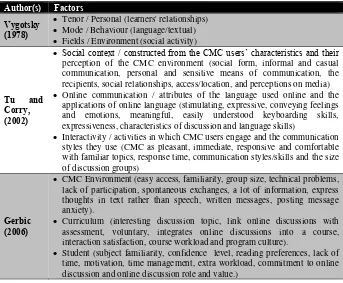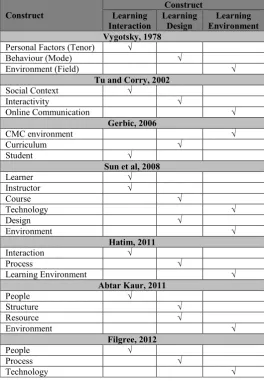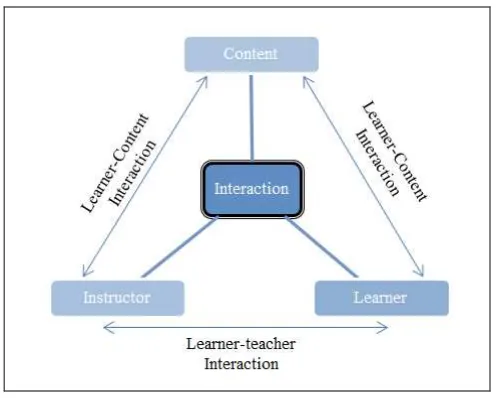Factors That Affecting The Effective Online
Collaborative Learning Environment
Sharifah Nadiyah Razali1,
Faaizah Shahbodin1 , Hanipah Hussin2, Norasiken Bakar1,
1
Faculty of Information and Communication Technology, 2
Centre for Languages and Human, University of Technical Malaysia Melaka,
Melaka, Malaysia.
[email protected], [email protected] [email protected].
Abstract. Interest in collaboration is a natural outgrowth of the trend in education toward active learning. Many researchers have found advantages of collaborative learning; it improves academic performance, promotes soft skills development (communication, collaboration, problem solving and critical thinking skills) and increases satisfaction in the learning experience. However, several studies have reported the opposite. Therefore, this paper aims to determine the factors to be considered in creating an effective online collaborative learning environment. In order to achieve the aims, this study was conducted qualitatively in the form of a document review. The results indicate three main factors that affect the effectiveness of Online Collaborative Learning Environments as Learning Environment, Learning Design, and Learning Interaction. An Online Learning Interaction model is also proposed according to the results. This study will continue to determine the elements that can clarify all the factors which have been identified in this study.
Keywords: Collaborative Learning, Online Collaborative Learning, Learning Interaction.
1 Introduction
Interest in collaboration is a natural outgrowth of the trend in education toward active learning, whereby students become involved in constructing their own knowledge through discovery, discussion, and expert guidance. Many published reports have outlined the advantages of collaborative learning, suggesting that it improves academic performance, promotes soft skills development (communication, collaboration, problem solving, and critical thinking skills) and increases satisfaction in the learning experience (refer Table 1).
Ada [4] tried to identify the interaction patterns and discourse quality of a CSCL environment. She found a positive relationship between the quality of the collaborative process and the quality of cognitive skills fostered. Besides that, she also found that effective collaborative learning can contribute to the establishment of a learning community and that it fosters high order thinking through knowledge processes. Because of the tedious and time-consuming coding process, she suggested other researchers to computerize the coding process.
Research done by [5] reported on pre-service teachers’ meaningful experiences in collaborative projects and how they had enriched their professional development. The results showed their professional development engagements were enriched by envisioning professional development, gaining and enhancing in five skills (planning and researching, problem-solving, the fundamental notion of learning, language skills and computing skills), sharing and exchanging information, knowledge ideas, views and opinions related to the tasks given and also teachers socializing within and between groups. For future research, they suggested that other researchers should also focus on additional popular online platforms such as Facebook, Academia.edu and LinkedIn as tools for their online professional development projects.
With the growth of web 2.0 technology, [6] investigated the differences between
students’ learning outcomes and satisfaction in a class using an online social
networking tool (Facebook) among different learning styles. There were four learning styles: Diverger, Assimilator, Converger and Accommodator. He found that the Converger group performed better and showed a more positive attitude toward
Facebook compared to other learning style groups. In the Converger group’s
perception, Facebook facilitated their interaction with others and improved content understanding in the class. For the future, he suggested examining the effects on different levels of learners to link the relationship of learning styles and the online social networking tool (Facebook).
Lee and Lim [7] investigated the important issues when it comes to students evaluating their peers in team project-based learning by analysing each message and comparing them with peer evaluation results. They classified the messages into four types: managerial, procedural, social and academic messages. The findings showed that all message types, except academic messages, predicted peer evaluation results. They concluded that students find social contribution to be more important compared to cognitive contribution when they evaluate peers. They suggested other research be done to compare the relationship between learning outcome by instructor’s evaluation, peer evaluation, and interaction message types.
Zhu [3] found that online collaborative learning can enhance students’ knowledge construction. He examined satisfaction with the online learning environment, their online performance, and knowledge construction via online group discussions of students in two different cultural contexts (Flemish and Chinese). The results showed there was a relationship between student satisfaction and academic achievement in an innovative e-learning environment. It also showed that online learning systems can
construction via group interaction. However, it was found that instructors evaluate the quality of the final product without knowledge of the teamwork process. Therefore, it was suggested that, in the future, researchers may want to not only study cognitive learning outcomes, but also social skills in collaborative learning outcomes.
The benefits of Collaborative Learning have been summarized in Table 1.
Table 1. Summarized of Collaborative Learning Benefits.
Author / Year
Contrary to this, other research has shown evidence that online learning can pose an even greater challenge for collaborative work than face-to-face (F2F) learning. According to [8], establishing and maintaining an active collaboration is a challenging task due to the lack of active participation by group members in their group work. Results from the interview session on Collaborative Learning experience in the research by [9] showed that there exists group tension towards the fairness of being given the same mark. Educators are not able to assume that every student makes an equal contribution to the group work and then allocate the same marks to all members [10]. Therefore, educators must allocate marks based on a student’s contribution to encourage students to participate actively in their group work activity [11].
Lee and Lim [7] found that instructors may not observe all the processes occurring within student groups and the evaluation are done only on the quality of the final product, ignoring the teamwork process. They suggested, instructors should closely monitor group interaction messages and do peer evaluations. Wang [12] also suggested that educators, including teachers and lecturers, should closely monitor how their students work together in a collaborative learning process for effective learning to take place. By monitoring the collaborative learning process, it can help
2 Materials and Methods
In order to achieve the aim, the study was conducted qualitatively in the form of a document review. According to [13] and [14], the document review method is the most appropriate tool to collect information in a qualitative study. Stewart [15] defines materials and resources that can be used as documents to carry out the analysis and interpretation of which are (i) journals and books, (ii) research literature, and (iii) reports from scholarly research papers and materials. Several previous studies including reports, conference proceedings and journals were referred to as a literature review. The collected data was then analysed using a matrix table [16].
3 Results and Discussion
Based on a review of documents, those factors affecting the effectiveness of Online Collaborative Learning environments are summarized in Table 2.
Table 2. Factors that affect the effectiveness of online collaborative learning environments.
Author(s) Factors
Vygotsky (1978)
Tenor / Personal (learners' relationships) Mode / Behaviour (language/textual) Fields / Environment (social activity)
Tu and Corry, (2002)
Social context / constructed from the CMC users’ characteristics and their perception of the CMC environment (social form, informal and casual communication, personal and sensitive means of communication, the recipients, social relationships, access/location, and perceptions on media) Online communication / attributes of the language used online and the
applications of online language (stimulating, expressive, conveying feelings and emotions, meaningful, easily understood keyboarding skills, expressiveness, characteristics of discussion and language skills)
Interactivity / activities in which CMC users engage and the communication styles they use (CMC as pleasant, immediate, responsive and comfortable with familiar topics, response time, communication styles/skills and the size of discussion groups)
Gerbic (2006)
CMC Environment (easy access, familiarity, group size, technical problems, lack of participation, spontaneous exchanges, a lot of information, express thoughts in text rather than speech, written messages, posting message anxiety).
Curriculum (interesting discussion topic, link online discussions with assessment, voluntary, integrates online discussions into a course, interaction satisfaction, course workload and program culture).
Author(s) Factors
Sun, Tsai, Finger, Chen, and Yeh (2008)
Learner (computer attitude, computer anxiety, Internet competence) Instructor (response time, e-learning attitude)
Course (flexibility, quality)
Technology (technology quality, internet quality) Design (Perceived usefulness, perceived ease of use) Environment (Assessment, interaction)
Ali (2011)
Learner
Learning process Content (subject matter) Learning environment Time constraints for learning Lecturer
Kaur, Shriram and Ravichan dran (2011)
People (dynamic, patience, subject knowledge, clear instruction, fellow students and support staff)
Structure (clear delineation and comprehensive activities) Environment (accessibility, navigation and support) Resources (varied, well selected and learning style)
Filigree (2012)
Technology (integrates learning spaces and flexible learning environment) People (training, guidance and support)
Process (high quality content, content relevance to subject and adapt pedagogical tools and models)
A matrix table has been drawn to determine the main factors affecting the effectiveness of Online Collaborative Learning environments using Straus and
Table 3. Matrix Table. that affect the effectiveness of Online Collaborative Learning: Learning Interaction, Learning Design and Learning Environment.
Fig. 1. Moore (1989) Interaction Model.
In the early stages of a collaborative learning environment, a number of studies to define the relationship between learner interaction involves only [1], [17], [18]. However, recent studies define interactivity not only involves learners with learners, but also involves the relationship between learners and teachers [19–22]. Previous researchers used different terms to define the relationship learner and learner-teacher relationship such Tenor, Social Context, Student, Learner and Instructor, Learner and Teacher and People. Therefore, in this study learning interactivity term will be used to define the interaction between learner-learner relationship and leaner-teacher relationship.
In learner–teacher interaction, teacher has to encourage students actively participate in online discussion using provided platform. Providing a suitable platform can facilitate and increase interaction and collaboration between leaners. It also helps teachers monitor student engagement. Previous study, [24] suggested to integrated current LMS with Facebook to enable students and lecturers communicate on Moodle through Facebook and also to facilitate Online Collaborative Learning [25]. Yeo and Quek [26] found technology mediation has supported interaction. Previous researchers using different term to define the learning platform such as: technology, field, CMC Environment, environment and Online environment but this study will use the term learning environment to define the platform using in learning.
The researchers proposed four interactions, which are: Learner-learner Interaction, Learner-teacher Interaction, Design Interaction and Environment Interaction (refer Fig. 2). There are two types of interactions in Learner interaction: Learner-learner Interaction and Learner-teacher interaction. In an Online environment, the Learner interaction can happen in either a synchronous or an asynchronous way. In a synchronous way, learners interact at the same time, while in an asynchronous way; the learners are not required to interact at the same time. Design Interaction is an interaction between learners and a given task. The task has the ability to enrich
learners’ behaviour. The interaction between learners and the environment is called Environment Interaction.
Fig. 2. Proposed Online Learning Interaction Model
4 Conclussion
Technology can be used to encourage learning process, support communication setting, assess learning activities, manage resources and create learning materials[28]. Technology is also seen as an important enabler for improving student-learning outcomes, but to get the greatest value from technology, best practices are required. There are five levels of collaboration maturity proposed by [22]. Basic, Partially Implemented, Integrated, Collaborative and Transformative. The report emphasized that collaborative learning is heavily rooted in the idea that learning is inherently social and can be facilitated with technology and proper practices. Collaborative learning not only promotes social skills, but also facilitates retention, improves the experience and enhances creativity. With higher levels of collaboration, greater results will be delivered.
that can clarify all the factors which have been identified in the previous section. Currently the model is only in a conceptual phase and requires significant development before it could be used to gather data.
Acknowledgments. Sharifah Nadiyah Razali would like to gratefully acknowledge
the financial support of Universiti Teknikal Malaysia Melaka (UTeM) and the Ministry of Higher Education of Malaysia for her PhD study.
References
[1] L. S. Vygotsky, Mind in Society. Cambridge (Massachusetts): Harvard University Press, 1978.
[2] R. T. Johnson, D.W., & Johnson, Cooperation and competition: Theory and research. Edina, MN: Interaction Book Company., 1989.
[3] C. Zhu, “Student Satisfaction , Performance , and Knowledge Construction in Online,” Educational Technology & Society, vol. 15, no. 1, pp. 127–136, 2012.
[4] Ada W. W. MA, “Computer supported collaborative learning and higher order
thinking skills: A case study of textile studies,” Interdisciplinary Journal of E-Learning and E-Learning Objects, vol. 5, pp. 145–167, 2009.
[5] M. K. Kabilan, W. F. W. Adlina, and M. A. Embi, “Online Collaboration of English Language Teachers for Meaningful Professional Development Experiences.,” English Teaching: Practice and Critique, vol. 10, no. 4, pp. 94–115, 2011.
[6] Y. Chen, “Learning styles and adopting Facebook technology,” in Technology Management in the Energy Smart World (PICMET), 2011, pp. 1–9.
[7] H.-J. Lee and C. Lim, “Peer Evaluation in Blended Team Project-Based Learning; What Do Students Find Important?,” Educational Technology & Society, vol. 15, no. 4, pp. 214–224, 2012.
[8] R. Chiong and J. Jovanovic, “Collaborative Learning in Online Study Groups: An Evolutionary Game Theory Perspective,” Journal of Information Technology
Education: …, vol. 11, pp. 81–101, 2012.
[9] Z. Zhang and Z. Han, “A Phenomenographic Study into Conceptions of Social
Relations in Online Collaborative Learning - Case Study of China Higher Education Learners,” in IEEE International Conference on Computer Science and Software Engineering (ICCSSE), 2008, pp. 146–149.
[10] Q. Wang, “Using online shared workspaces to support group collaborative learning,” Computers & Education, vol. 55, no. 3, pp. 1270–1276, Nov. 2010.
[11] K. Swan, S. R. S. Hiltz, and J. Shen, “Assessment and collaboration in online learning,” Journal of Asynchronous Learning Networks, vol. 10, no. 1, pp. 45–62, 2006.
[12] Q. Wang, “Design and evaluation of a collaborative learning environment,” Computers & Education, vol. 53, no. 4, pp. 1138–1146, Dec. 2009.
[13] M. E. Sallabas, “Analysis of narrative texts in secondary school textbooks in terms of values education,” African Journal of Business Education, vol. 1, no. 3, pp. 59–63, 2013.
[14] J. W. Best and J. V Kahn, Research In Eduction. United State of America: A Viacom Company, 1998.
[15] A. M. Stewart, “Research Guide for A Students and Teachers,” 2009.
[16] A. Strauss and J. Corbin, Basics of qualitative research: Grounded theory procedures and techniques. Newburry Park: CA: Sage, 1990.
[18] P. Gerbic, “To post or not to post: Undergraduate student perceptions about participating in online discussions,” Proceedings of the 23rd annual ascilite
conference: Who’s learning? Whose technology?, no. 1995, pp. 271–281, 2006.
[19] P. Sun, R. Tsai, G. Finger, Y. Chen, and D. Yeh, “What drives a successful e-Learning? An empirical investigation of the critical factors influencing learner satisfaction,” Computers & Education, vol. 50, pp. 1183–1202, 2008.
[20] H. Ali, “A comparison of cooperative learning and traditional lecture methods in the project management department of a tertiary level institution in Trinidad and Tobago,” The Caribbean Teaching Scholar, vol. 1, no. 1, pp. 49–64, 2011.
[21] A. Kaur, R. Shriram, and P. Ravichandran, “A Framework for Online Teaching and Learning: The S-CARE Pedagogical Model,” in 25th AAOU Annual Conference, 2011, pp. 1–12.
[22] C. Filigree, “Instructional Technology and Collaborative Learning Best Practices : Global Report and Recommendations,” 2012.
[23] M. G. Moore, “Three types of interaction.,” The American Journal of Distance Education, vol. 3, no. 2, pp. 1–6, 1989.
[24] R. Sharifah Nadiyah and S. Faaizah, “The Usage of CIDOS and Social Network Sites in Teaching and Learning Processes at Malaysian Polytechnics,” International Journal of Computer and Technology, vol. 13, no. 4, pp. 4354–4359, 2014.
[25] R. Sharifah Nadiyah, S. Faaizah, B. Norasiken, H. Hanipah, and A. Mohd Hafiez, “The need of incorporating Cidos with Facebook to facilitate online collaborative learning,” WIT transactions on Information and Communication Technologies, vol. 58, pp. 1089–1097, 2014.
[26] T. Yeo and C. Quek, “Investigating design and technology students’ peer interactions in a technology-mediated learning environment: A case study,” Australasian Journal of Educational Technology, vol. 27, no. 4, pp. 751–764, 2011.
[27] R. Sharifah Nadiyah, H. Hanipah, and S. Faaizah, “21 st Century Core Soft Skills Research Focus for Integrated Online Project Based Collaborative Learning Model,” Journal of Applied Science and Agriculture, vol. 9, no. 11, pp. 63–68, 2014. [28] C. K. M. Che Ku Nuraini, S. Faaizah, and C. P. Ahmad Naim, “Mapping of




